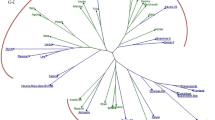Summary
We evaluated concordance of AFLP and RAPD markers for estimating genetic distances of 47 pepper inbred lines belonging to five varietal types. It enabled us to see the efficiency of these markers for identification, estimation of distances between varieties and variety discrimination. Genetic distance and multidimensional scaling results showed a general agreement between AFLP and RAPD markers. Based on pattern scores, dendrograms were produced by the UPGMA method. Phenetic trees based on molecular data were consistent with the classification of variety group. The precision of the estimation of the genetic distance was given. The molecular genetic distances were correlated with distances based on a set of discriminating agronomic traits measured for identification and distinctiveness tests. The relationship between molecular and morphological distances appeared to be triangular. These results and their implications in the cultivar protection purposes of pepper hybrids are discussed.
Similar content being viewed by others
Author information
Authors and Affiliations
Additional information
Received: 25 March 2000 / Accepted: 11 July 2000
Rights and permissions
About this article
Cite this article
Lefebvre, V., Goffinet, B., Chauvet, J. et al. Evaluation of genetic distances between pepper inbred lines for cultivar protection purposes: comparison of AFLP, RAPD and phenotypic data. Theor Appl Genet 102, 741–750 (2001). https://doi.org/10.1007/s001220051705
Issue Date:
DOI: https://doi.org/10.1007/s001220051705




